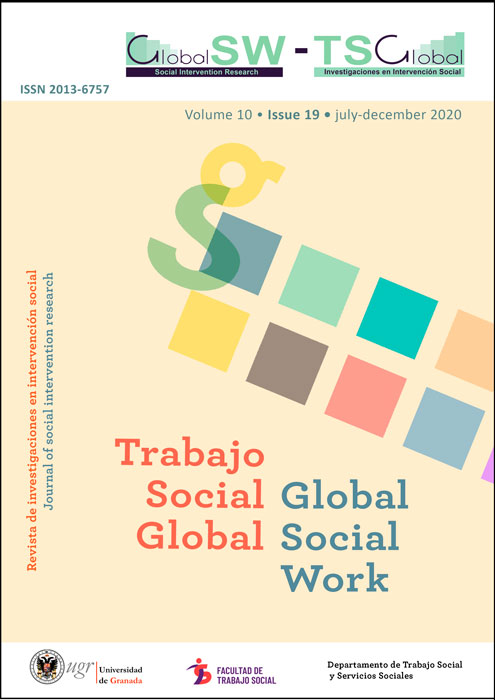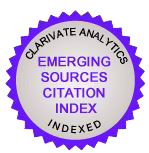Health promotion and social intervention with children and youngters with HIV: a ludic-educational program with peers and caregivers
DOI:
https://doi.org/10.30827/tsg-gsw.v10i19.15863Keywords:
Vírus da Imunodeficiência Humana (VIH), Crianças e jovens, Promoção da saúde, Intervenção Social, Serviço Social.Abstract
The article analyzes the program “A Brincar também se Aprende” [Learning through Playing], for children and young people with HIV and their families. There were 687 participants in 17 editions: 459 children and youth infected and affected by the diseaseand and 228 informal caregivers. Methodologically, the evaluation used the participants’ testimonies content analysis in 6 editions. Five main categories emerged, and the first three were the most mentioned: 1) Evaluation of the initiative, dynamics and planning; 2) Promotion of integration and interpersonal relationships; 3) Promotion of care and well-being; 4) Social support; 5) Strengthening and Valorization. The outcomes empirically support the program, and motivates it’s application in other social intervention contexts for children and youth affected with chronic illness, given the large potential in promoting health and psychosocial well-being.
Downloads
References
Bardin, L. (1977). L' Analyse de Contenu. Paris: Presses Univcrsitaires de France.
Betancourt, T. S., Abrams, E. J., McBain, R. & Fawzi, M. C. (2010). Family-centred approaches to the prevention of mother to child transmission of HIV. Journal of the International AIDS Society, 13(2). Doi: https://doi.org/10.1186/1758-2652-13-S2-S2
Candeias, N. M. F. (1997). Conceitos de educação e de promoção em saúde: mudanças individuais e mudanças organizacionais. Revista de Saúde Pública, 31(2), 209-213. Doi: https://dx.doi.org/10.1590/S0034-89101997000200016
Coscrato, G., Pina, J. C. & Mello, D. F. (2010). Utilização de atividades lúdicas na educação em saúde: uma revisão integrativa da literatura. Acta Paul Enfrem, 23(2), 257-63. Doi: http://dx.doi.org/10.1590/S0103-21002010000200017
Deeks, S. G., Lewin, S. R. & Havlir, D. V. (2013). The end of AIDS: HIV infection as a chronic disease. Lancet, 382(9903), 1525–1533. Doi: https://doi.org/10.1016/S0140-6736(13)61809-7
Drummond, I., Pinto, J. A., Santana, W. S. B., Modena, C. M. & Schall, V. T. (2009). A inserção do lúdico no tratamento da SIDA pediátrica. Análise Psicológica, 27(1), 33-43. Obtido de http://www.scielo.mec.pt/scielo.php?script=sci_arttext&pid=S0870-82312009000100003&lng=pt&tlng=pt
Gewirtz, A. & Gossart-Walker, S. (2000). Home-based treatment for children and families affected by HIV and AIDS: dealing with stigma, secrecy, disclosure, and loss. Child Adolescent Psychiatric Clinics North America, 9(2), 313-330. Obtido de https://pubmed.ncbi.nlm.nih.gov/10768069/
Gomes, R. (2011). Intervenção do Serviço Social. In G. Rocha et al. (org.). A infeção VIH na criança e no adolescente (pp.55-60). Grupo de trabalho sobre infeção VIH na criança. ASIC - Associação de Saúde Infantil de Coimbra. Obtido de https://www.spp.pt/UserFiles/file/Protocolos/Infecao_VIH_Crianca_Adolescente_Marco_2011.pdf
________ (2019). “A brincar também se aprende”: Análise e avaliação de um projeto de intervenção social (Dissertação de Mestrado em Serviço Social). Coimbra: Instituto Superior Miguel Torga.
Gonçalves, K. M. M., Costa, M. T. T. C. A., Silva, D. C. B., Baggio, M. E., Corrêa, A. R. & Manzo, B. F. (2020). Ludic strategy for promoting engagement of parents and caregivers in the safety of pediatric patients. Revista Gaúcha de Enfermagem, 41, e20190473. Doi: https://doi.org/10.1590/1983-1447.2020.20190473
Guadalupe, S. (2012). A intervenção do Serviço Social na Saúde com Famílias e em Redes de Suporte Social. In M.I. Carvalho (coord.). Serviço Social na Saúde (pp. xx-xx). Lisboa: Pactor.
Guerra, I. C. (2000). Fundamentos e Processos de Uma Sociologia de Acção. Cascais: Principia.
Idáñez, M. J. A. & Ander-Egg, E. (2002). Avaliação de Serviços e Programas Sociais. Lisboa: Projecto Atlântida.
Pereira, M. & Canavarro, M. C. (2010). Adversidade na gravidez: um estudo comparativo da adaptação de grávidas infectadas pelo VIH e grávidas sem risco médico associado. Psicologia, Saúde & Doenças, 11(2), 179-197. Obtido de http://www.scielo.mec.pt/scielo.php?pid=S1645-00862010000200002&script=sci_arttext&tlng=es
Rocha, G. (2016). Despedidas com a certeza do reencontró. Revista SIDA, 23, 14-16. Obtido de https://store.newsfarma.pt/sumarios/item/1080-sida-23-setembro-outubro-2016.html
Rocha, G., Gomes, R. & Branco, T. (2015). Ensinar medidas preventivas a crianças e adolescentes seropositivos. SIDA NewsFarma, 17, 8-11. Obtido de https://store.newsfarma.pt/sumarios-2015/item/815-sida-17-setembro-outubro-2015.html
Rocha, G., Marques, J. G., Marques, L., Prata, F. & Tavares, M. (2011). A infeção VIH na criança e no adolescente. Grupo de trabalho sobre infeção VIH na criança. ASIC - Associação de Saúde Infantil de Coimbra. Obtido de https://www.spp.pt/UserFiles/file/Protocolos/Infecao_VIH_Crianca_Adolescente_Marco_2011.pdf
Rotheram-Borus, M.J., Swendeman, D., Lee, S.J., Li, L., Amani, B. & Nartey, M. (2011). Interventions for families affected by HIV. Translational Behavioral Medicine, 1(2), 313–326. Doi: https://doi.org/10.1007/s13142-011-0043-1
Santos, J. R. & Minetto, G. P. (2013). O Lúdico na Educação Infantil e a prticipação do Serviço Social. Revista do Instituto de Pesquisas e Estudos. Obtido de http://ojs.ite.edu.br/index.php/css/article/download/133/180
Schenk, K. & Michaelis, A. (2010). Community interventions supporting children affected by HIV in sub-Saharan Africa: A review to derive evidence-based principles for programming. Vulnerable Children and Youth Studies, 5(sup1), 40–54. Doi: https://doi.org/10.1080/17450121003605261
Serapioni, M. (2016). Conceitos e métodos para a avaliação de programas sociais e políticas públicas. Sociologia, 31, 59-80. Obtido de
http://www.scielo.mec.pt/scielo.php?script=sci_arttext&pid=S0872-34192016000100004&lng=pt&tlng=pt.
UNAIDS (2020). Últimas estadísticas sobre el estado de la epidemia de sida. Obtido de https://www.unaids.org/sites/default/files/media_asset/UNAIDS_FactSheet_es.pdf
Vieira, I. D. (2017). A participação - Um paradigma para a Intervenção Social. Lisboa: Universidade Católica Editora.
Vranda, M. N. & Mothi, S. N. (2013). Psychosocial Issues of Children Infected with HIV/AIDS. Indian journal of psychological medicine, 35(1), 19–22. Doi: https://doi.org/10.4103/0253-7176.112195
Zannon, C. M. L. da C. (1991). Desenvolvimento psicológico da criança: Questões básicasrelevantes à intervenção comportamental no ambiente hospitalar. Psicologia, Teoria e Pesquisa, 7(2), 119-136.
Downloads
Published
How to Cite
Issue
Section
License
Authors publishing in this journal agree to the following terms:
- Authors retain their copyright. They guarantee to this journal the right to a first publication of the work submitted to initiate the editorial process.
- Authors know that their work is published under a Creative Commons License which allows others to share it, with a recognition of the work's authorship and its initial publication in this journal.
- Authors share with Global Social Work explotation rights of the work that has been published in this journal, authorizing the execution of a free reproduction, distribution and public communication. Authors know that their work will be stored on servers and reproduced in digital format for inclusion in institutional repositories and databases that will facilitates free access to the full text of the work.
- Authors may distribute the version of the work published in this journal (for example, to an institutional repository or publish it in a book), with the explicit acknowledgment of its initial publication in this journal.
Copyright on the texts published in Trabajo Social Global -Global Social Work, as well as editorial policy of the journal refering to self-file and deposit in institutional or thematic repositories, are identified in the database





















